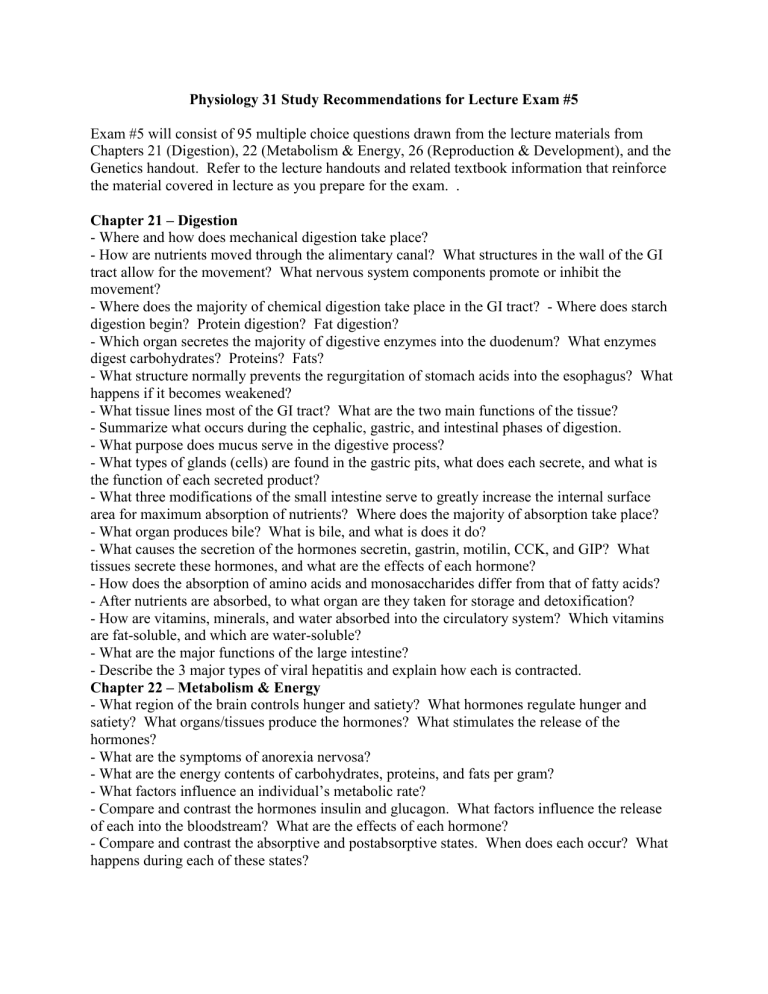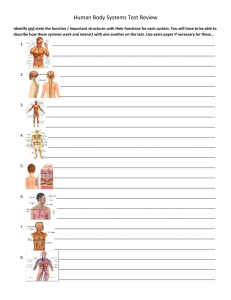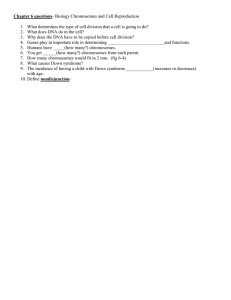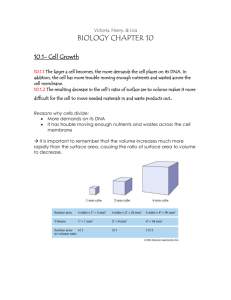Lecture Exam 5 Study Guide

Physiology 31 Study Recommendations for Lecture Exam #5
Exam #5 will consist of 95 multiple choice questions drawn from the lecture materials from
Chapters 21 (Digestion), 22 (Metabolism & Energy, 26 (Reproduction & Development), and the
Genetics handout. Refer to the lecture handouts and related textbook information that reinforce the material covered in lecture as you prepare for the exam. .
Chapter 21 – Digestion
- Where and how does mechanical digestion take place?
- How are nutrients moved through the alimentary canal? What structures in the wall of the GI tract allow for the movement? What nervous system components promote or inhibit the movement?
- Where does the majority of chemical digestion take place in the GI tract? - Where does starch digestion begin? Protein digestion? Fat digestion?
- Which organ secretes the majority of digestive enzymes into the duodenum? What enzymes digest carbohydrates? Proteins? Fats?
- What structure normally prevents the regurgitation of stomach acids into the esophagus? What happens if it becomes weakened?
- What tissue lines most of the GI tract? What are the two main functions of the tissue?
- Summarize what occurs during the cephalic, gastric, and intestinal phases of digestion.
- What purpose does mucus serve in the digestive process?
- What types of glands (cells) are found in the gastric pits, what does each secrete, and what is the function of each secreted product?
- What three modifications of the small intestine serve to greatly increase the internal surface area for maximum absorption of nutrients? Where does the majority of absorption take place?
- What organ produces bile? What is bile, and what is does it do?
- What causes the secretion of the hormones secretin, gastrin, motilin, CCK, and GIP? What tissues secrete these hormones, and what are the effects of each hormone?
- How does the absorption of amino acids and monosaccharides differ from that of fatty acids?
- After nutrients are absorbed, to what organ are they taken for storage and detoxification?
- How are vitamins, minerals, and water absorbed into the circulatory system? Which vitamins are fat-soluble, and which are water-soluble?
- What are the major functions of the large intestine?
- Describe the 3 major types of viral hepatitis and explain how each is contracted.
Chapter 22 – Metabolism & Energy
- What region of the brain controls hunger and satiety? What hormones regulate hunger and satiety? What organs/tissues produce the hormones? What stimulates the release of the hormones?
- What are the symptoms of anorexia nervosa?
- What are the energy contents of carbohydrates, proteins, and fats per gram?
- What factors influence an individual’s metabolic rate?
- Compare and contrast the hormones insulin and glucagon. What factors influence the release of each into the bloodstream? What are the effects of each hormone?
- Compare and contrast the absorptive and postabsorptive states. When does each occur? What happens during each of these states?
2
- What is the main breakdown product of carbohydrates, such as starch? Where, and in what form is glucose stored in the body? How is glucose used in the body? What alternate molecules can be used in cellular respiration if glucose is depeleted? (Hint: recall gluconeogenesis)
- What is the main nutrient molecule metabolized by the brain? If that molecule is depleted, what alternate molecule can the brain use? What is the main consequence of the use of the alternate molecule?
- What are the breakdown products of proteins? What are the products used for in the body?
- What are the breakdown products of fats (triglycerides)? What are the products used for in the body?
- Compare and contrast HDLs and LDLs. Why is one considered “good” cholesterol, and the other harmful in high concentrations?
- Compare and contrast Type 1 and Type 2 Diabetes mellitus. What causes each, and what are the results of each type.
- What causes ketoacidosis? What are the symptoms of ketoacidosis? What can be done to alleviate ketoacidosis in a Type 1 diabetic?
Chapter 26 – Reproduction & Development
- In what way do the sex chromosomes of the male and female differ?
- How is it that some people have more or less than two sex chromosomes? What conditions result from abnormal numbers of X or Y chromosomes?
- Which parent’s gamete actually determines the gender of the offspring?
- How does the Y chromosome influence the development of an embryo into a male?
- In an embryo, what determines whether the Wolffian duct or the Mullerian duct continues to develop? What does each duct become? What does the genital tubercle become in the male and in the female?
- What are the functions of the testes in the male? What structures produce sperm? What cells produce androgens? What hormones control these functions?
- What are the functions of the ovaries in the female? What do ovarian follicles produce? What hypothalamic and pituitary hormones influence ovarian functions? Describe the ovarian cycle.
- Describe the uterine cycle. What two hormones produced by ovarian follicles and the corpus luteum help to maintain the endometrial lining in preparation for a fertilized egg? What hormone produced by the blastocyst maintains the corpus luteum?
- What is a blastocyst? What do the trophoblast layer and inner cell mass become during embryonic development? How does the blastocyst implant itself in the uterine lining?
- What are the 3 embryonic germ layers, and what does each become in the embryo/fetus?
- What are the 4 main extraembryonic membranes? What is the function of each?
- What is the placenta, from what embryonic structure does it form, and what are its functions?
- The embryonic notochord and neural plate will become what structures in the fetus?
- Describe the changes the embryo undergoes during the 3 rd
-8 th
weeks. When does the heart first begin to beat? What is the embryo called from the end of the 8 th
week until birth?
- What are teratogens, and during what stage of pregnancy are they the most damaging to embryonic/fetal development?
Chromosomes, DNA & Genetics
- What are genes, and where are they found in a cell? How many chromosomes are found in the nuclei of normal human cells?
- Describe the structure of DNA. What are nucleotides composed of? What are the four types of nitrogenous bases?
- During what phase of the cell cycle do chromosomes (and DNA) replicate themselves? Which nucleotides are joined by hydrogen bonds as complementary bases during DNA replication?
- What are the main functions of DNA?
- Compare and contrast mitosis and meiosis. Which produces diploid cells, and which results in haploid cells? What is each process used for in the body?
- How do homologous chromosome pairs differ from chromatid pairs? Which of these are separated during Anaphase 1 and during Anaphase 2 during meiosis? Which are separated during Anaphase of mitosis?
- What are mutagens, and how do they affect DNA?
- What are proto-oncogenes, and what can they become if a DNA mutation takes place?
- What do the genotypes homozygous dominant, heterozygous, and homozygous recessive mean?
- What is the difference between a genotype, a phenotype, and a karyotype?
- How do autosomal dominant disorders differ from autosomal recessive disorders? Give examples of each.
- What is phenylketonuria (PKU)? How can its detrimental effects be prevented?
- What is meant by complete dominance, incomplete dominance, and codominance in genetics?
Cite examples of these three types of genetic dominance.
- What are sex-linked traits? Which gender inherits more X-linked disorders? From which parent does a male inherit an X-linked disorder?
- What is meant by multiple alleles for a given trait? Give an example of multiple alleles. Do individuals normally have more than 2 alleles for a monogenetic trait?
- How does DNA direct the formation of proteins?
- What occurs during transcription? In what part of the cell does it occur? What type of RNA is involved? What is a codon? How many nucleotides form a codon? What nucleotide replaces thymine in RNA?
- How is mRNA modified before it moves into the cytoplasm for translation?
- What occurs during translation? How are mRNA, tRNA, and rRNA involved? Which RNA dictates the sequence of amino acid sequence brought to form the protein? Which RNA brings the amino acids? What is an anticodon?
3




